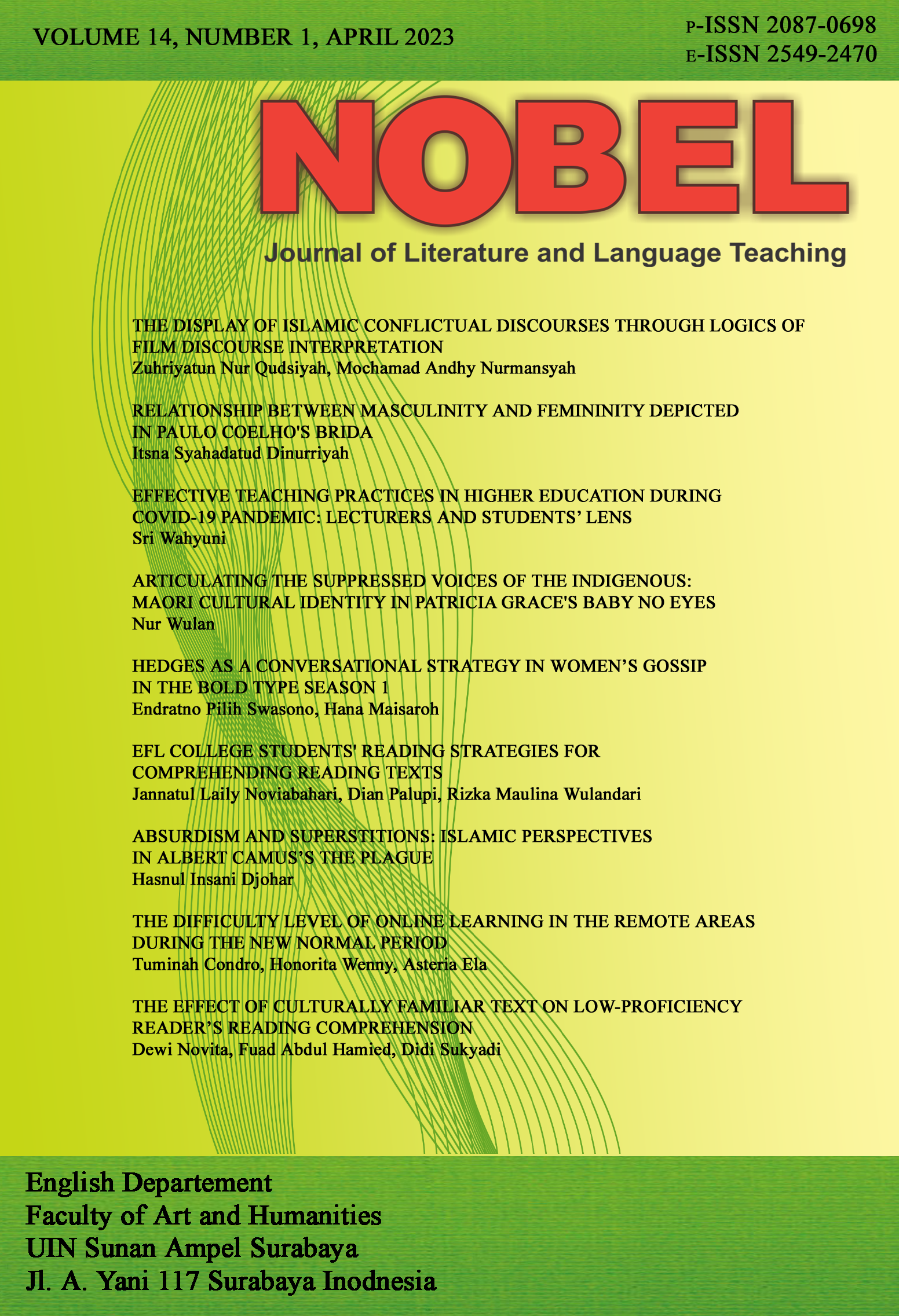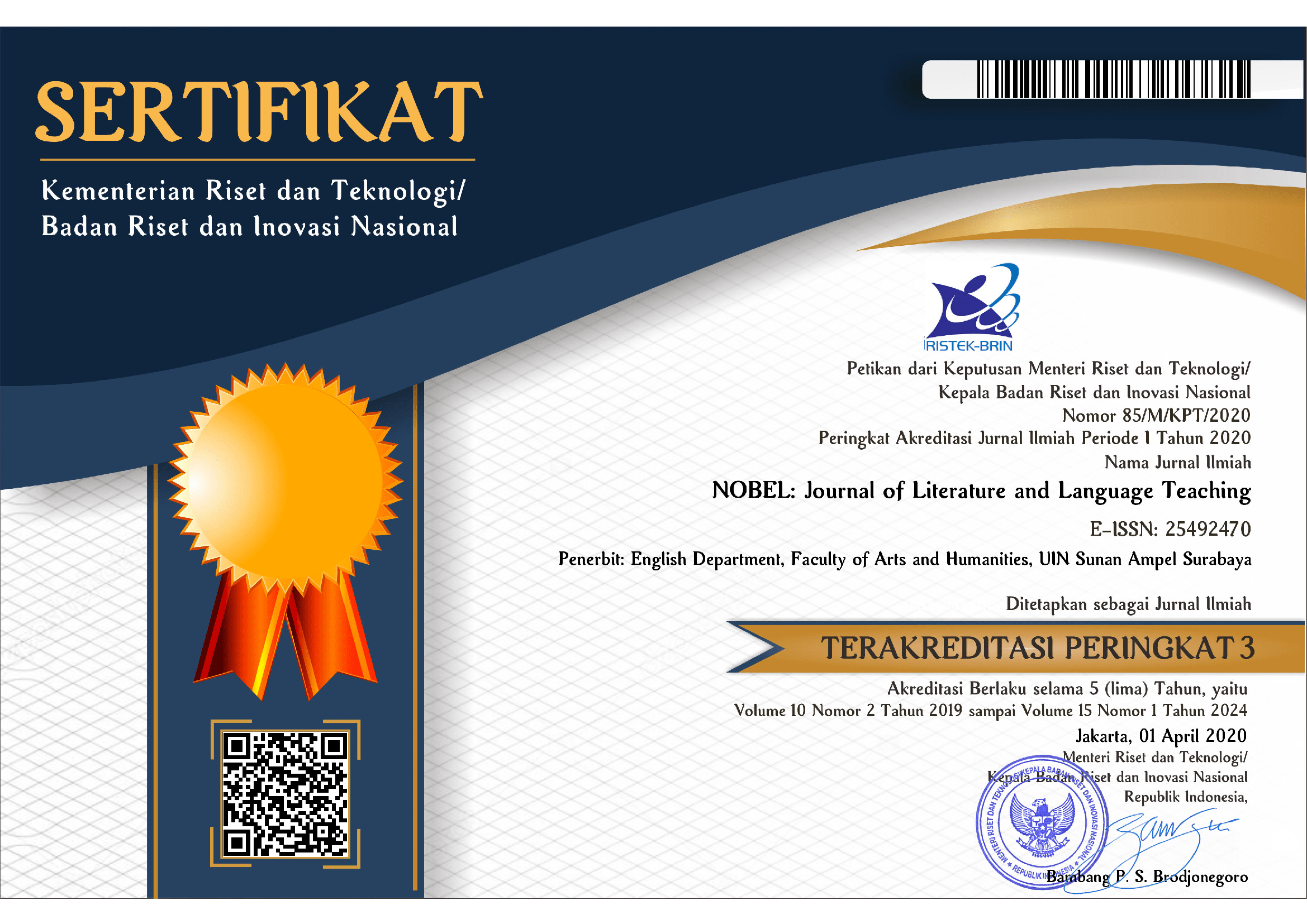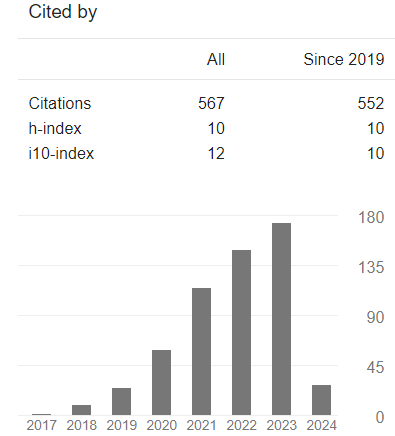Articulating the Suppressed Voices of the Indigenous
Maori Cultural Identity in Patricia Grace's Baby No Eyes
DOI:
https://doi.org/10.15642/NOBEL.2023.14.1.45-55Keywords:
Maori, non-linear narrative, indigeneous people, subaltern, colonizerAbstract
This article examines how Patricia Grace’s Baby No Eyes (BNE) amplifies Maori cultural identity. Specifically, this study discusses how the novel places Maori in the center as a way to subvert the colonial and conventional way of writing about the indigenous people. The data is collected from the novel’s narrative structure, points of view, and contents. The analysis focuses on the narrative about the marginalization of Maori by the White people. The novel uses a non-linear narrative that resembles Maori’s story-telling tradition, offering an alternative way of telling stories greatly dominated by modern Western linearity. The novel also employs multiple points of view, representing the egalitarian Maori tradition of giving chances to everybody in telling stories in the community hall. In terms of its contents, BNE foregrounds fundamental issues to the survival of Maori in the land that has been controlled by European descendants. These range from the issue of land rights to the contemporary life of Maori. This article argues that the novel offers a dual approach in articulating the voice of the subaltern: the narrative of resistance in the novel and the invitation for Maori to negotiate their tradition and customs in the changing world.
Downloads
References
A’Court, M. (1998). Baby no-eyes (A book review). New Zealand Herald.
André, S. (2009). From a feminine imagination to a collective imagination: The struggle of Polynesian women authors to express themselves. Comparative Critical Studies, 6(2), 201–220. https://doi.org/10.3366/E1744185409000706
Bardolph, J. (1990). An invisible presence: Three Maori writers. Third World Quarterly, 12(2), 131–136. https://www.jstor.org/stable/3992263
Brewster, A., MacDonald, A., & Kossew, S. (2019). Introduction: Gender and violence in cultural texts of the Global South. Australian Humanities Review, 64(May 2019), 87–101. https://australianhumanitiesreview.org/2019/05/27/introduction-gender-and-violence-in-cultural-texts-of-the-global-south/?utm_source=rss&utm_medium=rss&utm_campaign=introduction-gender-and-violence-in-cultural-texts-of-the-global-south
Crowl, M. (2002). Baby no-eyes by Patricia Grace. http://www.geocities.com/Athens/Forum/4657/book/baby.html
DeLoughrey, L., & Hall, S. (1999). Beginning from a centre (An interview with Patricia Grace). New Zealand Books, 9(1), 13–14. https://nzbooks.org.nz/1999/literature/liz-deloughrey-and-susan-hall-interview-patricia-grace/
Eagleton, D. (1992). A child reclaimed. New Zealand Listener, 40.
Evers, E. J. (2020). Contesting New Zealand’s past: Postmemory, transgenerational trauma and the implicated subject in Māori renaissance literature [Utrecht University]. https://studenttheses.uu.nl/handle/20.500.12932/877
Grace, P. (1998). Baby no eyes. Penguin Books.
Grace, P. (1999). Influences on writing. In V. Hereniko & R. Wilson (Eds.), Inside out: Literature, Cultural, Politics, and Identity in the New Pacific (pp. 64–74). Rowman and Littlefield.
Keown, M. (2013). ‘Sheddings of light’: Patricia Grace and Māori short fiction. In M. Awadalla & P. March-Russell (Eds.), The Postcolonial Short Story: Contemporary Essays (pp. 33–48). Palgrave Macmillan.
Kroplewska, E. (2017). Voicing the Maori issue: Patricia Grace’s “Small Holes in the Silence: Short Stories.” Beyond Philology An International Journal of Linguistics, Literary Studies and English Language Teaching, 14(2), 103–119. https://czasopisma.bg.ug.edu.pl/index.php/beyond/article/view/2649
McRae, J. (1993). Patricia Grace and complete communication. Australian & New Zealand Studies in Canada, 10, 66–86.
Pistacchi, A. K. (2009). Spiraling subversions: The politics of Māori cultural survivance in the critical fictions of Patricia Grace, Paula Morris, and Kelly Ana Morey [University of Auckland]. https://researchspace.auckland.ac.nz/handle/2292/4528
Ramsay, R. (2012). Indigenous women writers in the Pacific: Déwé Gorodé, Sia Figiel, Patricia Grace. Postcolonial Text, 7(1), 1–18. https://www.postcolonial.org/index.php/pct/article/view/1199
Robinson, R. (1993). “The strands of life and self”: The oral prose of Patricia Grace. RNLE Reviews Journal, 1, 13–27. https://natlib-primo.hosted.exlibrisgroup.com/primo-explore/fulldisplay?vid=NLNZ&docid=INNZ7119038220002837&context=L&search_scope=INNZ
Tausky, T. E. (1991). Stories that show them who they are: An interview with Patricia Grace. Australia and New Zealand Studies in Canada, 6(Autumn), 90–102.
Wattie, N. (1999). Subtle use of myth. New Zealand Books, 9(1), 14–15. https://nzbooks.org.nz/1999/literature/subtle-use-of-myth-nelson-wattie/
Whaitiri, R. (2000). Baby no-eyes (review). The Contemporary Pacific, 12(2), 554–556. 10.1353/cp.2000.0069
Wilson, R. (1999). Introduction: Toward imagining a new Pacific. In V. Hereniko & R.
Wilson (Eds.), Inside out: Literature, Cultural, Politics, and Identity in the New Pacific (pp. 1–12). Rowman and Littlefield.
Downloads
Published
How to Cite
Issue
Section
License
Copyright (c) 2023 NOBEL: Journal of Literature and Language Teaching

This work is licensed under a Creative Commons Attribution 4.0 International License.







